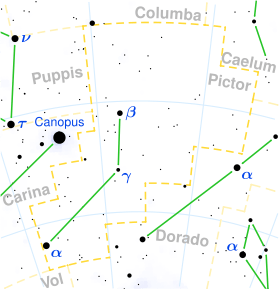Gamma Pictoris
Gamma Pictoris, Latinized from γ Pictoris, is a single,[9] orange-hued star in the southern constellation of Pictor. It is a faintly visible to the naked eye with an apparent visual magnitude of 4.50.[2] Based upon an annual parallax shift of 18.45 mas as seen from Earth,[1] this star is located about 177 light years from the Sun. It is moving away from the Sun with a radial velocity of +15.7 km/s.[5]
| Observation data Epoch J2000 Equinox J2000 | |
|---|---|
| Constellation | Pictor |
| Right ascension | 05h 49m 49.66181s[1] |
| Declination | −56° 09′ 59.9808″[1] |
| Apparent magnitude (V) | 4.50[2] |
| Characteristics | |
| Spectral type | K1 III[3] |
| U−B color index | +0.98[4] |
| B−V color index | +1.10[4] |
| Astrometry | |
| Radial velocity (Rv) | +15.7±0.8[5] km/s |
| Proper motion (μ) | RA: +81.13[1] mas/yr Dec.: −71.12[1] mas/yr |
| Parallax (π) | 18.45 ± 0.15[1] mas |
| Distance | 177 ± 1 ly (54.2 ± 0.4 pc) |
| Absolute magnitude (MV) | 0.83[2] |
| Details | |
| Mass | 1.59[6] M☉ |
| Radius | 11[6] R☉ |
| Luminosity | 60.75[2] L☉ |
| Surface gravity (log g) | 2.56[6] cgs |
| Temperature | 4,600[7] K |
| Metallicity [Fe/H] | +0.15[2] dex |
| Rotational velocity (v sin i) | 6.4[8] km/s |
| Other designations | |
| Database references | |
| SIMBAD | data |
This is an evolved K-type giant star with a stellar classification of K1 III.[3] It has 1.59 times the mass of the Sun, while its diameter has been estimated as around 11 times that of the Sun.[6] The star is radiating 61[2] times the Sun's luminosity from its enlarged photosphere at an effective temperature of around 4,600 K.[7]
References
- Van Leeuwen, F. (2007). "Validation of the new Hipparcos reduction". Astronomy and Astrophysics. 474 (2): 653. arXiv:0708.1752. Bibcode:2007A&A...474..653V. doi:10.1051/0004-6361:20078357. Vizier catalog entry
- Anderson, E.; Francis, Ch. (2012). "XHIP: An extended hipparcos compilation". Astronomy Letters. 38 (5): 331. arXiv:1108.4971. Bibcode:2012AstL...38..331A. doi:10.1134/S1063773712050015. Vizier catalog entry
- Hoffleit, D.; Warren, W. H. (1995). "VizieR Online Data Catalog: Bright Star Catalogue, 5th Revised Ed. (Hoffleit+, 1991)". VizieR On-line Data Catalog: V/50. Originally Published in: 1964BS....C......0H. 5050. Bibcode:1995yCat.5050....0H.
- Mallama, A. (2014). "Sloan Magnitudes for the Brightest Stars". The Journal of the American Association of Variable Star Observers. 42: 443. Bibcode:2014JAVSO..42..443M.Vizier catalog entry
- Gontcharov, G. A. (2006). "Pulkovo Compilation of Radial Velocities for 35 495 Hipparcos stars in a common system". Astronomy Letters. 32 (11): 759. arXiv:1606.08053. Bibcode:2006AstL...32..759G. doi:10.1134/S1063773706110065.
- Allende Prieto, C.; Lambert, D. L. (1999). "Fundamental parameters of nearby stars from the comparison with evolutionary calculations: Masses, radii and effective temperatures". Astronomy and Astrophysics. 352: 555. arXiv:astro-ph/9911002. Bibcode:1999A&A...352..555A. Vizier catalog entry
- Gontcharov, G. A. (2009). "Red giant clump in the Tycho-2 catalogue". Astronomy Letters. 34 (11): 785. arXiv:1607.00619. Bibcode:2008AstL...34..785G. doi:10.1134/S1063773708110078. Vizier catalog entry
- De Medeiros, J. R.; Alves, S.; Udry, S.; Andersen, J.; Nordström, B.; Mayor, M. (2014). "A catalog of rotational and radial velocities for evolved stars". Astronomy & Astrophysics. 561: A126. arXiv:1312.3474. Bibcode:2014A&A...561A.126D. doi:10.1051/0004-6361/201220762. Vizier catalog entry
- Eggleton, P. P.; Tokovinin, A. A. (September 2008), "A catalogue of multiplicity among bright stellar systems", Monthly Notices of the Royal Astronomical Society, 389 (2): 869–879, arXiv:0806.2878, Bibcode:2008MNRAS.389..869E, doi:10.1111/j.1365-2966.2008.13596.x.
This article is issued from Wikipedia. The text is licensed under Creative Commons - Attribution - Sharealike. Additional terms may apply for the media files.
